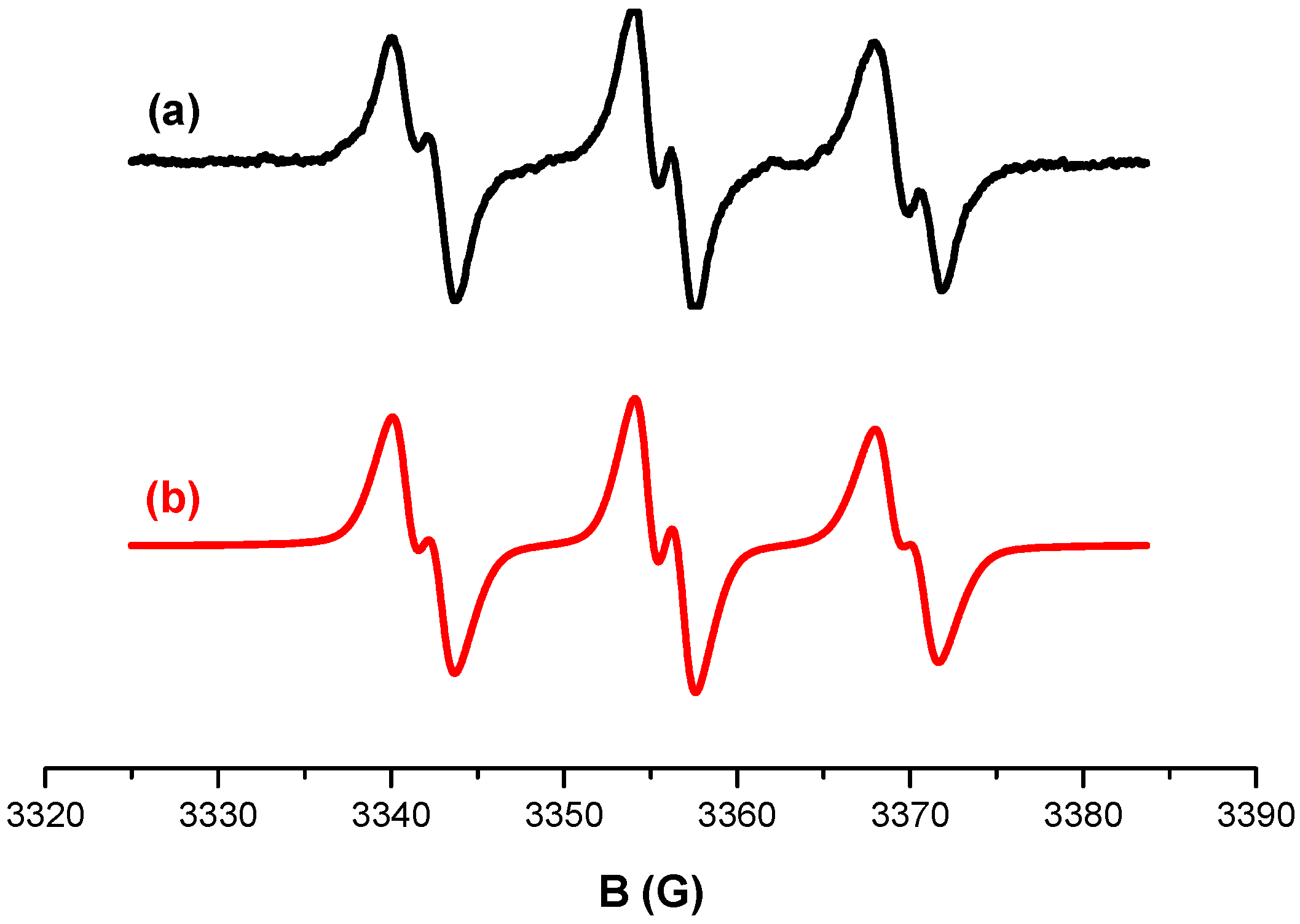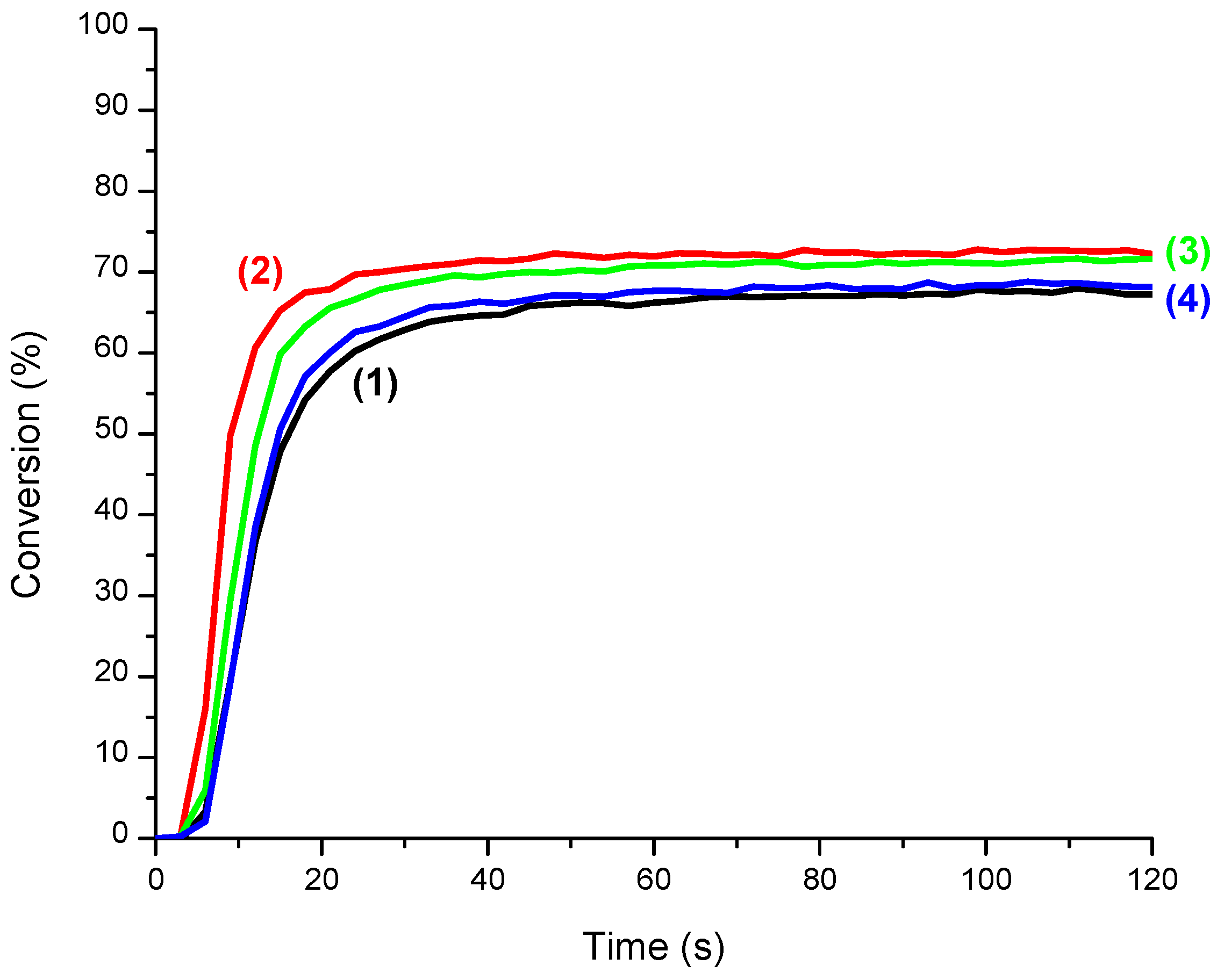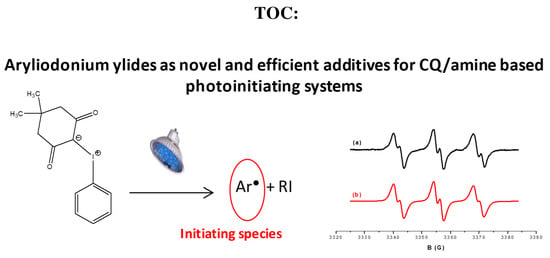Aryliodonium Ylides as Novel and Efficient Additives for Radical Chemistry: Example in Camphorquinone (CQ)/Amine Based Photoinitiating Systems
Abstract
:1. Introduction
2. Materials and Methods
2.1. Materials
2.2. Synthesis of Aryliodonium Ylides S5 and S6
2.3. Irradiation Sources
2.4. Absorption Experiments
2.5. Photopolymerization Experiments
2.6. ESR Spin Trapping Experiments:
3. Results and Discussion
3.1. Photochemical Mechanism
3.2. Absorption Properties
3.3. CQ/EDB/S5 and CQ/EDB/S6 Initiating Ability
3.4. CQ/EDB/S5 and CQ/EDB/S6 for the Polymerization of Thin Samples of Methacrylates and Adhesives under Air
4. Conclusions
Author Contributions
Funding
Acknowledgments
Conflicts of Interest
References
- Fouassier, J.P.; Lalevée, J. Photoinitiators for Polymer Synthesis-Scope, Reactivity and Efficiency; Wiley-VCH Verlag GmbH & Co. KGaA: Weinheim, Germany, 2012. [Google Scholar]
- Yagci, Y.; Jockusch, S.; Turro, N.J. Photoinitiated polymerization: Advances, challenges and opportunities. Macromolecules 2010, 43, 6245–6260. [Google Scholar] [CrossRef]
- Nakabayashi, N. Contribution of polymer chemistry to dentistry: Development of an impermeable interpenetrating polymer network to protect teeth from acid demineralization. Polym. Int. 2008, 57, 159–162. [Google Scholar] [CrossRef]
- Irving, H.; Reid, R.W. 421. The photochemical decomposition of diphenyliodonium iodide. J. Chem. Soc. 1960, 2078–2081. [Google Scholar] [CrossRef]
- Nickol, S.L.; Kampmeier, J.A. Photolysis of a charge transfer complex. Triphenylsulfonium iodide. J. Am. Chem. Soc. 1973, 95, 1908–1915. [Google Scholar] [CrossRef]
- Ortyl, J.; Popielarz, R. New photoinitiators for cationic polymerization. Polimery 2012, 57, 510–517. [Google Scholar] [CrossRef]
- Crivello, J.V. The discovery and development of onium salt cationic photoinitiators. J. Polym. Sci. Part A Polym. Chem. 1999, 37, 4241–4254. [Google Scholar] [CrossRef]
- Crivello, J.V. Cationic polymerization—Iodonium and sulfonium salt photoinitiators. In Initiators—Poly-Reactions—Optical Activity; Advances in Polymer Science; Springer: Berlin/Heidelberg, Germany, 1984; Volume 62. [Google Scholar]
- Crivello, J.V.; Lam, J.H.W. Diaryliodonium salts. A new class of photoinitiators for cationic polymerization. Macromolecules 1977, 10, 1307–1315. [Google Scholar] [CrossRef]
- Mokbel, H.; Toufaily, J.; Hamieh, T.; Dumur, F.; Campolo, D.; Gigmes, D.; Fouassier, J.P.; Ortyl, J.; Lalevée, J. Specific cationic photoinitiators for near UV and visible LEDs: Iodonium versus ferrocenium structures. J. Appl. Polym. Sci. 2015, 132, 42759. [Google Scholar] [CrossRef]
- Hua, Y.; Crivello, J.V. Development of polymeric photosensitizers for photoinitiated cationic polymerization. Macromolecules 2001, 34, 2488–2494. [Google Scholar] [CrossRef]
- Walsh, T.D.; Long, R.C. Photochemistry of aromatic ions. Photolysis of quaternary anilinium salts. J. Am. Chem. Soc. 1967, 89, 3943–3944. [Google Scholar] [CrossRef]
- Kabatc, J.; Ortyl, J.; Kostrzewska, K. New kinetic and mechanistic aspects of photosensitization of iodonium salts in photopolymerization of acrylates. RSC Adv. 2017, 7, 41619–41629. [Google Scholar] [CrossRef] [Green Version]
- Devoe, R.J.; Sayhun, M.R.V.; Serpone, N.; Sharma, D.K. Transient intermediates in the photolysis of iodonium cations. Can. J. Chem. 1987, 65, 2342–2349. [Google Scholar] [CrossRef]
- Dektar, J.L.; Hacker, N.P. Photochemistry of diaryliodonium salts. J. Org. Chem. 1990, 55, 639–647. [Google Scholar] [CrossRef]
- Jakubiak, J.; Allonas, X.; Fouassier, J.P.; Sionkowska, A.; Andrzejewska, E.; Linden, L.A.; Rabek, J.F. Camphorquinone-amines photoinitiating systems for the initiation of free radical polymerization. Polymer 2003, 44, 5219–5226. [Google Scholar] [CrossRef]
- Bi, Y.; Neckers, D.C. A visible light initiating system for free radical promoted cationic polymerization. Macromolecules 1994, 27, 3683–3693. [Google Scholar] [CrossRef]
- Cook, W.D. Photopolymerization kinetics of dimethacrylates using the camphorquinone/amine initiator system. Polymer 1992, 33, 600–609. [Google Scholar] [CrossRef]
- Shiraishi, A.; Kimura, H.; Oprych, D.; Schmitz, C.; Strehmel, B. Comparison between NIR and UV-sensitized radical and cationic reactivity of iodonium salts comprising anions with different coordination behavior. J. Photopolym. Sci. Technol. 2017, 30, 633–638. [Google Scholar] [CrossRef]
- Shiraishi, A.; Ueda, Y.; Schläpfer, M.; Schmitz, C.; Brömme, T.; Oprych, D.; Strehmel, B. NIR-sensitized photopolymerization with iodonium salts bearing weak coordination anions. J. Photopolym. Sci. Technol. 2016, 29, 609–615. [Google Scholar] [CrossRef]
- Huddleston, J.G.; Visser, A.E.; Reichert, W.M.; Willauer, H.D.; Broker, G.A.; Rogers, R.D. Characterization and comparison of hydrophilic and hydrophobic room temperature ionic liquids incorporating the imidazolium cation. Green Chem. 2001, 3, 156–164. [Google Scholar] [CrossRef]
- Tseng, M.C.; Liang, Y.M.; Chu, Y.H. Synthesis of fused tetrahydro-β-carbolinequinoxalinones in 1-n-butyl-2,3-dimethylimidazolium bis(trifluoromethylsulfonyl)imide ([bdmim][Tf2N]) and 1-n-butyl-2,3-dimethylimidazolium perfluorobutylsulfonate ([bdmim][PFBuSO3]) ionic liquids. Tetrahedron Lett. 2005, 46, 6131–6136. [Google Scholar] [CrossRef]
- Schank, K.; Lick, C. Ozonolytic fragmentation of phenyliodonium β-diketonates; a convenient synthesis of unsolvated vic-triketones. Synthesis 1983, 5, 392–395. [Google Scholar] [CrossRef]
- Tehfe, M.A.; Lalevée, J.; Telitel, S.; Sun, J.; Zhao, J.; Graff, B.; Morlet-Savary, F.; Fouassier, J.P. Iridium complexes incorporating coumarin moiety as catalyst photoinitiators: Towards household green LED bulb and halogen lamp irradiation. Polymer 2012, 53, 2803–2808. [Google Scholar] [CrossRef]
- Criqui, A.; Lalevée, L.; Allonas, X.; Fouassier, J.P. Electron spin resonance spin trapping technique: Application to the cleavage process of photoinitiators. Macromol. Chem. Phys. 2008, 209, 2223–2231. [Google Scholar] [CrossRef]
Sample Availability: Samples of the compounds S5 and S6 are available from the authors. |











© 2019 by the authors. Licensee MDPI, Basel, Switzerland. This article is an open access article distributed under the terms and conditions of the Creative Commons Attribution (CC BY) license (http://creativecommons.org/licenses/by/4.0/).
Share and Cite
Kirschner, J.; Paillard, J.; Bouzrati-Zerelli, M.; Becht, J.-M.; Klee, J.E.; Chelli, S.; Lakhdar, S.; Lalevée, J. Aryliodonium Ylides as Novel and Efficient Additives for Radical Chemistry: Example in Camphorquinone (CQ)/Amine Based Photoinitiating Systems. Molecules 2019, 24, 2913. https://doi.org/10.3390/molecules24162913
Kirschner J, Paillard J, Bouzrati-Zerelli M, Becht J-M, Klee JE, Chelli S, Lakhdar S, Lalevée J. Aryliodonium Ylides as Novel and Efficient Additives for Radical Chemistry: Example in Camphorquinone (CQ)/Amine Based Photoinitiating Systems. Molecules. 2019; 24(16):2913. https://doi.org/10.3390/molecules24162913
Chicago/Turabian StyleKirschner, Julie, Julien Paillard, Mariem Bouzrati-Zerelli, Jean-Michel Becht, Joachim E. Klee, Saloua Chelli, Sami Lakhdar, and Jacques Lalevée. 2019. "Aryliodonium Ylides as Novel and Efficient Additives for Radical Chemistry: Example in Camphorquinone (CQ)/Amine Based Photoinitiating Systems" Molecules 24, no. 16: 2913. https://doi.org/10.3390/molecules24162913
APA StyleKirschner, J., Paillard, J., Bouzrati-Zerelli, M., Becht, J.-M., Klee, J. E., Chelli, S., Lakhdar, S., & Lalevée, J. (2019). Aryliodonium Ylides as Novel and Efficient Additives for Radical Chemistry: Example in Camphorquinone (CQ)/Amine Based Photoinitiating Systems. Molecules, 24(16), 2913. https://doi.org/10.3390/molecules24162913








